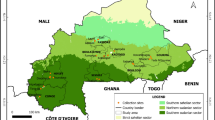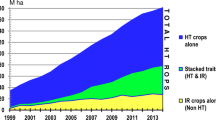Abstract
Hairy fleabane is a weed found increasingly in agronomic crops and rural areas. Although glyphosate resistance is now widespread in this species, the ecological fitness of glyphosate-resistant (GR) and glyphosate-susceptible (GS) populations has not been compared. When seeds of both biotypes were subjected to different alternating temperature, germination occurring and seedling vigor did not differ between the biotypes with maximum germination at 10/20 and 15/25 °C. Under noncompetitive conditions, growth and seed production of the GR and GS biotypes were similar. The competitive ability of the two biotypes, as determined by a replacement series experiment, was also similar. Initially, the relative crowding coefficient (RCC) between the biotypes was close to one. However, the RCC values for each characteristic increased with time indicating that the GR had a small competitive advantage as plants matured. Overall, there was no apparent fitness penalty associated to glyphosate resistance. Therefore, the GR populations are likely to persist unless effective management strategies are adopted.




Similar content being viewed by others
References
Abdul Baki AA, Anderson JD (1973) Vigour determination in soybean seed by multiple criteria. Crop Sci 13:630–633
Alcocer-Ruthling M, Thill DC, Shafii B (1992) Differential competitiveness of sulfonylurea resistant and susceptible prickly lettuce (Lactuca serriola). Weed Technol 6:303–309
Baylis AD (2000) Why glyphosate is a global herbicide: strengths, weaknesses and prospects. Pest Manag Sci 56:299–308
Beckie HJ (2011) Herbicide-resistant weed management: focus on glyphosate. Pest Manag Sci 67:1037–1048
Bradshaw LD, Padgette SR, Kimball SL, Wells BH (1997) Perspectives on glyphosate resistance. Weed Technol 11:189–198
Davis VM, Kruger GR, Stachler JM, Loux MM, Johnson WG (2009) Growth and seed production of horseweed (Conyza canadensis) populations resistant to glyphosate, ALS-inhibiting, and multiple (glyphosate + ALS-inhibiting) herbicides. Weed Sci 57:494–504
Dill GM (2005) Glyphosate-resistant crops: history, status and future. Pest Manag Sci 61:219–224
Duff MG, Al-Khatib K, Peterson DE (2009) Relative competitiveness of protoporphyrinogen oxidase-resistant common waterhemp (Amaranthus rudis). Weed Sci 57:169–174
Gill GS, Cousens RD, Allan MR (1996) Germination, growth, and development of herbicide resistant and susceptible populations of rigid ryegrass (Lolium rigidum). Weed Sci 44:252–256
Harper JL (1977) The population biology of plants. Academic Press, London
Heap I (2011) The international survey of herbicide resistant weeds. http://www.weedscience.org. Accessed 12 Oct 2011
Hoagland DR, Arnon DI (1950) The water-culture method for growing plants without soil. California Agricultural Experiment Station Circle, p 347
Holt JS (1990) Fitness and ecological adaptability of herbicide-resistant biotypes. Am Chem Soc 421:419–429
Karlsson LM, Milberg P (2007) Comparing after-ripening response and germination requirements of Conyza canadensis and C. bonariensis (Asteraceae) through logistic functions. Weed Res 47:433–441
Marshall MW, Al-Khatib K, Loughin T (2001) Gene flow, growth, and competitiveness of imazethapyr-resistant common sunflower. Weed Sci 49:14–21
Massinga RA, Al-Khatib K, Amand PS, Miller JF (2005) Relative fitness of imazamox-resistant common sunflower and prairie sunflower. Weed Sci 53:166–174
Novak MG, Higley LG, Christianssen CA, Rowling WA (1993) Evaluating larval competition between Aedes albopictus and A. triseriatus (Diptera: Culcidae) through replacement series experiments. Environ Entomol 22:311–318
Owen MDK, Zelaya IA (2005) Herbicide-resistant crops and weed resistance to herbicides. Pest Manag Sci 61:301–311
Park KW, Mallory-Smith CA, Ball DA, Mueller-Warrant GW (2004) Ecological fitness of acetolactate synthase inhibitor-resistant and -susceptible downy brome (Bromus tectorum) biotypes. Weed Sci 52:768–773
Powles SB (2008) Evolved glyphosate-resistant weeds around the world: lessons to be learnt. Pest Manag Sci 64:360–365
Prieur-Richard AH, Lavorel S, Grigulis K, Dos-Santos A (2000) Plant community diversity and invasibility by exotics: invasion of Mediterranean old fields by Conyza bonariensis and Conyza canadensis. Ecol Lett 3:412–422
Shrestha A, Hanson BD, Fidelibus MW, Alcorta M (2010) Growth, phenology, and intraspecific competition between glyphosate-resistant and glyphosate-susceptible horseweeds (Conyza canadensis) in the San Joaquin valley of California. Weed Sci 58:147–153
Sibony M, Rubin B (2003) The ecological fitness of ALS-resistant Amaranthus retroflexus and multiple resistant Amaranthus blitoides. Weed Res 43:40–47
Steinmaus SJ, Prather TS, Holt JS (2000) Estimation of base temperatures for nine weed species. J Exp Bot 51:275–286
Thompson CR, Thill DC, Shafii B (1994) Germination characteristics of sulfonylurea-resistant and -susceptible kochia (Kochia scoparia). Weed Sci 42:50–56
Travlos IS, Chachalis D (2010) Glyphosate-resistant hairy fleabane (Conyza bonariensis) is reported in Greece. Weed Technol 24:569–573
Travlos IS, Chachalis D, Economou G (2009a) Characters for the in situ recognition of some Conyza species and glyphosate resistant populations from Greece. In: Proceedings of 2nd international conference on novel sustainable weed management in arid and semi-arid agro-ecosystems. EWRS, Santorini, p 63
Travlos IS, Economou G, Kotoulas VE, Kanatas PJ, Kontogeorgos AN, Karamanos AI (2009b) Potential effects of diurnally alternating temperatures on purple nutsedge (Cyperus rotundus) tuber sprouting. J Arid Environ 73:22–25
Urbano JM, Borrego A, Torres V, Leon JM, Jimenez C, Dinelli G, Barnes J (2007) Glyphosate-resistant hairy fleabane (Conyza bonariensis) in Spain. Weed Technol 21:396–401
Vaughn KC (2003) Herbicide resistance work in the United States Department of Agriculture—agricultural research service. Pest Manag Sci 59:764–769
Vila-Aiub MM, Neve P, Steadman KJ, Powles SB (2005) Ecological fitness of a multiple herbicide-resistant Lolium rigidum population: dynamics of seed germination and seedling emergence of resistant and susceptible phenotypes. J Appl Ecol 42:288–298
Westhoven AM, Kruger GR, Gerber CK, Stachler JM, Loux MM, Johnson WG (2008) Characterization of selected common lambsquarters (Chenopodium album) biotypes with tolerance to glyphosate. Weed Sci 56:685–691
Woodburn A (2000) Glyphosate: production, pricing and use worldwide. Pest Manag Sci 56:309–312
Wu H, Walker S, Rollin MJ, Tan DKY, Robinson G, Werth J (2007) Germination, persistence, and emergence of fleaxleaf fleabane (Conyza bonariensis [L.] Cronquist). Weed Biol Manag 7:192–199
Zelaya IA, Owen MDK, VanGessel MJ (2004) Inheritance of evolved glyphosate resistance in Conyza canadensis (L.) Cronq. Theor Appl Genet 110:58–70
Author information
Authors and Affiliations
Corresponding author
Additional information
Communicated by M. Traugott
Rights and permissions
About this article
Cite this article
Travlos, I.S., Chachalis, D. Relative competitiveness of glyphosate-resistant and glyphosate-susceptible populations of hairy fleabane, Conyza bonariensis . J Pest Sci 86, 345–351 (2013). https://doi.org/10.1007/s10340-012-0446-x
Received:
Accepted:
Published:
Issue Date:
DOI: https://doi.org/10.1007/s10340-012-0446-x




